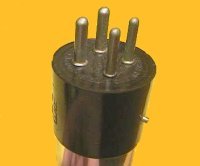
WL765
|
|
|||||||||||||||||||||||||||||
|
Hits: 1614 Replies: 2
a peculiar device
|
|
|
Wolfgang Holtmann
08.Oct.16 |
1
Lately, on a meeting with radiofriends, someone came up with this interesting glass tube: On the bottom we see two pins leading to a sort of heater wire. The measured resistance is appr. 5 Ohms. The writing is hardly to identify. With the use of a magnifier lens one can make up: APC-8065 CELL, 110V, ITALY The first idea was, could it be a so called Vacuum-Gauge? No, because a third connection is missing! Any suggestions are welcome.... Regards
|
|
Emilio Ciardiello
09.Oct.16 |
2
Likely it is a Pirani vacuum gauge. This kind of sensor is based upon the convection cooling of a wire, heated by a current flowing in it, by molecules of rarefied gas inside the bulb. The final temperature gives an indication of the vacuum reached. The sensor is used in a bridge circuit, sometimes with a second sealed sensor as reference, which supplies current to the filament and returns at the same time an unbalance due to the resistance value corresponding to the vacuum. Look as example at WL765 or at R1111. Emilio |
|
Wolfgang Holtmann
09.Oct.16 |
3
Many thanks Emilio for the explanations!
Credit to Wikipedia for the depicted diagram. Regards, Wolfgang |
End of forum contributions about this tube
| Data Compliance | More Information |


